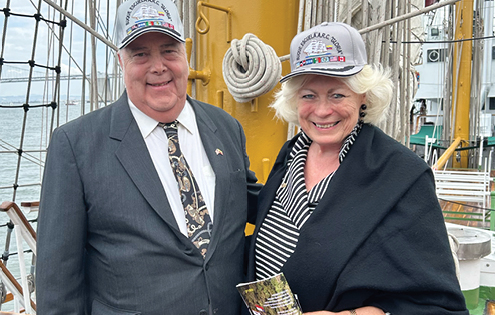San Francisco Tech Week and Fleet Week, both October 6–12, brought together a decentralized, city-wide technology festival and a celebration of America’s U.S. Armed Forces sea services. Invitations to both events were extended internationally.

Chile
In recognition of Tech Week, the Chile California Council and Pro Chile hosted an October 6 gathering focused on Bridging AI & Innovation — bridging Silicon Valley’s pioneering spirit with Latin America’s vibrant innovation ecosystem, exploring how artificial intelligence and innovation are reshaping industries and societies.
The council’s mission is to connect the public and private sectors of Chile and California in order to boost the economies of the future through science and technology, for nature and for people.
Chile was the first country in South America to join the OECD (Organisation for Economic Co-operation and Development), becoming a member in 2010. Chile has the most stable and fastest-growing economy in the region which puts it in the best position to promote democracy and political freedom.
Trade with Chile
Since the U.S.-Chile Free Trade Agreement was implemented on January 1, 2004, bilateral trade between Chile and the United States has nearly quadrupled and both trade and investment opportunities abound.
Upon entry into force of the U.S.-Chile Free Trade Agreement (FTA) in 2004, 80% of U.S. consumer and industrial goods exports to Chile immediately became duty free. Tariffs on the remaining products were phased out, with 100% of products duty-free in 2015. The more recent administration tariffs have put a damper on this trade.
Two-way trade in goods between the United States and Chile was approximately $34.65 billion in 2024 — $18.23 billion in exports and $16.42 billion in imports.
In 2024, Chile was California’s 21st largest export destination with $1.84 billion in exports. Top exports from California to Chile include petroleum and coal products, computer and electronic products, processed foods, chemicals, and non-electrical machinery.
Imports from Chile to California totaled $1.30 billion in 2024. Top imports from Chile to California include agricultural products, wood products, processed foods, fish and other marine products, and chemicals.

Colombia
Recognizing Fleet Week, Ambassador of Colombia to the United States, Dr. Daniel García-Peña, and Captain Luis Fernando Lara Cogollo, Commander of the Colombian Navy’s Training Ship ARC Gloria held a formal luncheon for 20 guests on October 9 while the ship docked in San Francisco.
The Gloria is Colombia’s flagship of goodwill, international friendship, and global trade ties.
Ambassador García-Peña and Consul General Sonia Marina Pereira Portilla used the presence of the Gloria in San Francisco as an opportunity to personally engage with leaders who maintain strong ties with Colombia and strengthen links with California’s business and trade community.
Colombia was the second country in South America to join the OECD, becoming a member in 2020, a decade after Chile.
Trade with Colombia
In November 2006, the United States and Colombia signed a free trade agreement. When the U.S.-Colombia Trade Promotion Agreement entered into force in May 2012, 80% of U.S. consumer and industrial exports to Colombia were duty-free immediately. The remaining tariffs phased out over 10 years. U.S. farmers and ranchers also became much more competitive, benefiting from immediate duty-free treatment of 77% of U.S. agriculture exports. Colombia phased out all other agricultural tariffs.
Once again, the more recent administration tariffs have put a damper on this trade.
Since 2006, both U.S. and California exports to Colombia have nearly doubled. In 2024, the United States exported $18.70 billion of goods to Colombia and imported $17.87 billion, with two-way trade amounting to $36.56 billion.
In 2024, California goods exports to Colombia totaled $484 million, nearly triple the amount in 2006. Colombia now is California’s 38th largest export market. Top California exports to Colombia are computer and electronic products, chemicals, processed foods, miscellaneous manufactures, and non-electrical machinery.
Total imports from Colombia in the same year were $1.54 billion. The top five imports from Colombia to California include oil and gas, agricultural products, processed foods, chemicals, and computer and electronic products.

